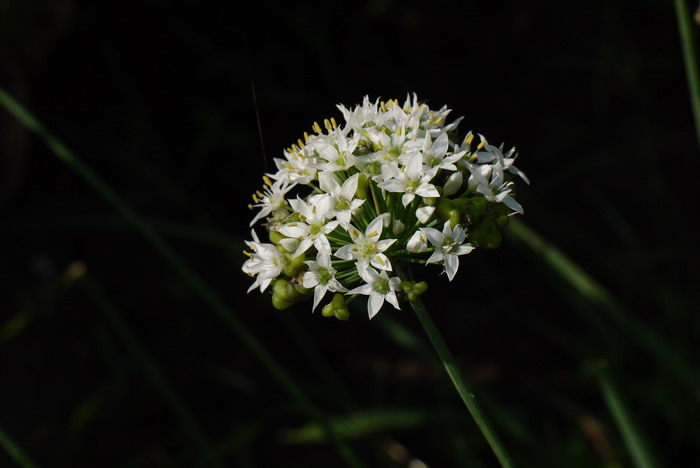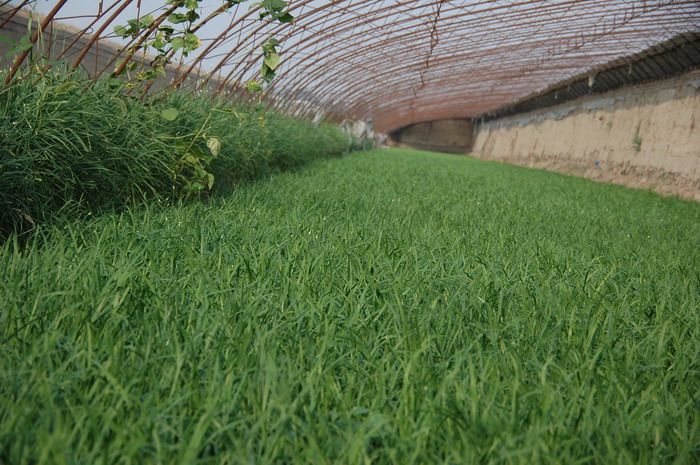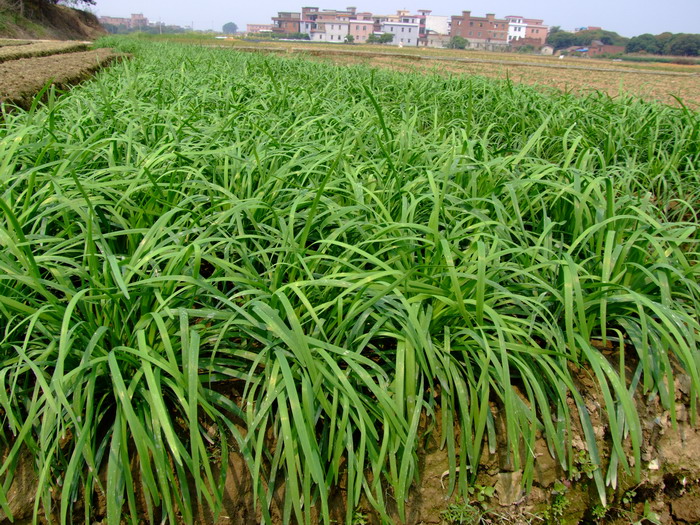韭Allium tuberosum
中文名(Chinese Name):韭
学名(Scientific Name):Allium tuberosum Rottler ex Spreng.
英文名(English Common Name):Chinese chives
别名(Chinese Common Name):
异名(Synonym):Allium roxburghii Kunth Allium sulvia Buch.-Ham. ex D. Don Allium argyi H. Lév. Allium clarkei Hook. f. Allium yesoense Nakai Nothoscordum sulvia (Buch.-Ham. ex D.Don) Kunth Allium yezoense Nakai Allium tuberosum f. yezoense (Nakai) M.Hiroe
科属(Family & Genus):百合科(Liliaceae)葱属
形态特征(Description):具倾斜的横生根状茎。鳞茎簇生,近圆柱状;鳞茎外皮暗黄色至黄褐色,破裂成纤维状,呈网状或近网状。叶条形,扁平,实心,比花葶短,宽1.5-8毫米,边缘平滑。花葶圆柱状,常具2纵棱,高25-60厘米,下部被叶鞘;总苞单侧开裂,或2-3裂,宿存;伞形花序半球状或近球状,具多但较稀疏的花;小花梗近等长,比花被片长2-4倍,基部具小苞片,且数枚小花梗的基部又为1枚共同的苞片所包围;花白色;花被片常具绿色或黄绿色的中脉,内轮的矩圆状倒卵形,稀为矩圆状卵形,先端具短尖头或钝圆,长4-7 (-8) 毫米,宽2.1-3.5毫米,外轮的常较窄,矩圆状卵形至矩圆状披针形,先端具短尖头,长4-7(-8)毫米,宽1.8-3毫米;花丝等长,为花被片长度的2/3-4/5,基部合生并与花被片贴生,合生部分高0.5-1毫米,分离部分狭三角形,内轮的稍宽;子房倒圆锥状球形,具3圆稜,外壁具细的疣状突起。花果期7-9月。
分布(Distribution):全国广泛栽培,亦有野生植株,但北方的为野化植株。原产亚洲东南部。现在世界上已普遍栽培。叶、花葶和花均作蔬菜食用;种子入药。
用途(Use):
引自植物志英文版:FOC Vol. 24 Page 179
Allium tuberosum Rottler ex Sprengel, Syst. Veg. 2: 38. 1825.
韭 jiu| Liliaceae | Allium
Allium argyi H. Léveillé; A. chinense Maximowicz (1859), not G. Don (1827); A. clarkei J. D. Hooker; A. roxburghii Kunth; A. sulvia Buchanan-Hamilton ex D. Don; A. tuberosum Roxburgh (1832); A. uliginosum G. Don (1827), not Ledebour (1830); A. yesoense Nakai.
Bulbs clustered, cylindric; tunic dull yellow to yellowish brown, reticulate to subreticulate. Leaves linear, shorter than scape, 1.5--8 mm wide, flat, solid, margin smooth. Scape 25--60 cm, terete, usually 2-angled, covered with leaf sheaths only at base. Spathe 2- or 3-valved, persistent. Umbel hemispheric to subglobose, laxly many flowered. Pedicels subequal, 2--4 × as long as perianth, bracteolate and several covered with a common bract at base. Perianth white; segments usually with green or yellowish green midvein; outer ones oblong-ovate to oblong-lanceolate, 4--7(--8) × 1.8--3 mm; inner ones oblong-obovate, 4--7(--8) × 2.1--3.5 mm. Filaments narrowly triangular, equal, 2/3--4/5 as long as perianth segments, connate at base and adnate to perianth segments; inner ones slightly wider than outer at base. Ovary obconical-globose, minutely tuberculate, without concave nectaries at base. Fl. and fr. Jul--Sep. 2 n = 16*, 24*, 32*.
Among shrubs, also widely cultivated as a vegetable; 1000--1100 m. Native in SW Shanxi (Yongji Xian); naturalized S China [tropical Asia].
Allium tuberosum is generally regarded as a cultivated species with a tetraploid chromosome number (2 n = 32), although a wild population was recently discovered in Shanxi Province with a diploid number (2 n = 16; Yang et al., Acta Phytotax. Sin. 36: 36--46. 1998). This species has leaves solid and perianth segments usually with a green or yellowish green midvein, whereas its close wild relative, A. ramosum, differs in having leaves fistulose and perianth segments with a pale red midvein. One of us (Xu) agrees with Stearn (Herbertia 11: 238. 1946) that the name A. tataricum Linnaeus f. (Suppl. Pl. 196. 1782) should be regarded as a synonym of A. ramosum. On the other hand, Kamelin regards A. tataricum as a synonym of A. tuberosum over which name it would have priority. He bases his opinion on two specimens (LE), labeled as A. tataricum and made from plants cultivated during the 1790s in the St. Petersburg Botanical Garden, and on his belief that only A. tuberosum never A. ramosum, has been cultivated. However, Kamelin has observed that these two specimens have fistulose leaves, which suggests that they are A. ramosum, unless this character is not diagnostic for the two species. Xu has not seen the specimens but notes that they could be cultivated A. ramosum because, as noted by Stearn (loc. cit.: 229), A. ramosum was already in cultivation in Europe by 1750. Therefore, A. tataricum is here treated as a synonym of A. ramosum, based on Xu’s opinion. The nomenclature of the two species remains unstable because, although the type of A. tuberosum (B) supports the current application of that name, no type has yet been designated for either A. ramosum or A. tataricum. Further studies are required in order to resolve the classification.


 (责任编辑:徐晔春)
(责任编辑:徐晔春)
学名(Scientific Name):Allium tuberosum Rottler ex Spreng.
英文名(English Common Name):Chinese chives
别名(Chinese Common Name):
异名(Synonym):Allium roxburghii Kunth Allium sulvia Buch.-Ham. ex D. Don Allium argyi H. Lév. Allium clarkei Hook. f. Allium yesoense Nakai Nothoscordum sulvia (Buch.-Ham. ex D.Don) Kunth Allium yezoense Nakai Allium tuberosum f. yezoense (Nakai) M.Hiroe
科属(Family & Genus):百合科(Liliaceae)葱属
形态特征(Description):具倾斜的横生根状茎。鳞茎簇生,近圆柱状;鳞茎外皮暗黄色至黄褐色,破裂成纤维状,呈网状或近网状。叶条形,扁平,实心,比花葶短,宽1.5-8毫米,边缘平滑。花葶圆柱状,常具2纵棱,高25-60厘米,下部被叶鞘;总苞单侧开裂,或2-3裂,宿存;伞形花序半球状或近球状,具多但较稀疏的花;小花梗近等长,比花被片长2-4倍,基部具小苞片,且数枚小花梗的基部又为1枚共同的苞片所包围;花白色;花被片常具绿色或黄绿色的中脉,内轮的矩圆状倒卵形,稀为矩圆状卵形,先端具短尖头或钝圆,长4-7 (-8) 毫米,宽2.1-3.5毫米,外轮的常较窄,矩圆状卵形至矩圆状披针形,先端具短尖头,长4-7(-8)毫米,宽1.8-3毫米;花丝等长,为花被片长度的2/3-4/5,基部合生并与花被片贴生,合生部分高0.5-1毫米,分离部分狭三角形,内轮的稍宽;子房倒圆锥状球形,具3圆稜,外壁具细的疣状突起。花果期7-9月。
分布(Distribution):全国广泛栽培,亦有野生植株,但北方的为野化植株。原产亚洲东南部。现在世界上已普遍栽培。叶、花葶和花均作蔬菜食用;种子入药。
用途(Use):
引自植物志英文版:FOC Vol. 24 Page 179
Allium tuberosum Rottler ex Sprengel, Syst. Veg. 2: 38. 1825.
韭 jiu| Liliaceae | Allium
Allium argyi H. Léveillé; A. chinense Maximowicz (1859), not G. Don (1827); A. clarkei J. D. Hooker; A. roxburghii Kunth; A. sulvia Buchanan-Hamilton ex D. Don; A. tuberosum Roxburgh (1832); A. uliginosum G. Don (1827), not Ledebour (1830); A. yesoense Nakai.
Bulbs clustered, cylindric; tunic dull yellow to yellowish brown, reticulate to subreticulate. Leaves linear, shorter than scape, 1.5--8 mm wide, flat, solid, margin smooth. Scape 25--60 cm, terete, usually 2-angled, covered with leaf sheaths only at base. Spathe 2- or 3-valved, persistent. Umbel hemispheric to subglobose, laxly many flowered. Pedicels subequal, 2--4 × as long as perianth, bracteolate and several covered with a common bract at base. Perianth white; segments usually with green or yellowish green midvein; outer ones oblong-ovate to oblong-lanceolate, 4--7(--8) × 1.8--3 mm; inner ones oblong-obovate, 4--7(--8) × 2.1--3.5 mm. Filaments narrowly triangular, equal, 2/3--4/5 as long as perianth segments, connate at base and adnate to perianth segments; inner ones slightly wider than outer at base. Ovary obconical-globose, minutely tuberculate, without concave nectaries at base. Fl. and fr. Jul--Sep. 2 n = 16*, 24*, 32*.
Among shrubs, also widely cultivated as a vegetable; 1000--1100 m. Native in SW Shanxi (Yongji Xian); naturalized S China [tropical Asia].
Allium tuberosum is generally regarded as a cultivated species with a tetraploid chromosome number (2 n = 32), although a wild population was recently discovered in Shanxi Province with a diploid number (2 n = 16; Yang et al., Acta Phytotax. Sin. 36: 36--46. 1998). This species has leaves solid and perianth segments usually with a green or yellowish green midvein, whereas its close wild relative, A. ramosum, differs in having leaves fistulose and perianth segments with a pale red midvein. One of us (Xu) agrees with Stearn (Herbertia 11: 238. 1946) that the name A. tataricum Linnaeus f. (Suppl. Pl. 196. 1782) should be regarded as a synonym of A. ramosum. On the other hand, Kamelin regards A. tataricum as a synonym of A. tuberosum over which name it would have priority. He bases his opinion on two specimens (LE), labeled as A. tataricum and made from plants cultivated during the 1790s in the St. Petersburg Botanical Garden, and on his belief that only A. tuberosum never A. ramosum, has been cultivated. However, Kamelin has observed that these two specimens have fistulose leaves, which suggests that they are A. ramosum, unless this character is not diagnostic for the two species. Xu has not seen the specimens but notes that they could be cultivated A. ramosum because, as noted by Stearn (loc. cit.: 229), A. ramosum was already in cultivation in Europe by 1750. Therefore, A. tataricum is here treated as a synonym of A. ramosum, based on Xu’s opinion. The nomenclature of the two species remains unstable because, although the type of A. tuberosum (B) supports the current application of that name, no type has yet been designated for either A. ramosum or A. tataricum. Further studies are required in order to resolve the classification.
踩一下[0]

顶一下[1]